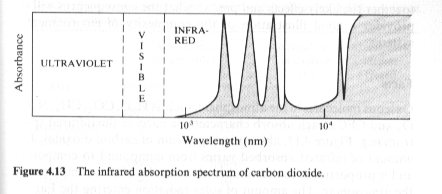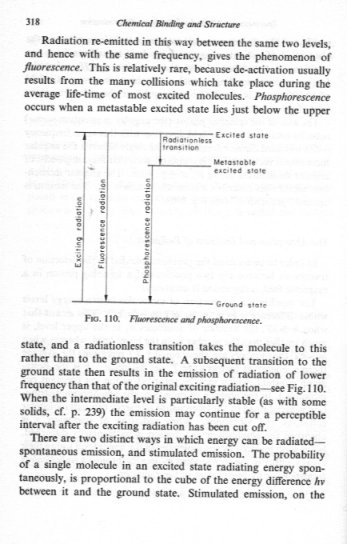-
Posts
18270 -
Joined
-
Last visited
-
Days Won
104
Content Type
Profiles
Forums
Events
Everything posted by studiot
-
You did not answer my question. Period. Since you made several statements to form your chain of reasoning, I am taking them one at a time and correcting them. You cannot expect the rest of the chain to be correct if the first statement in the chain is lacking. So please reply to my question. Without using existing light to generate heat, what is the connection between thermally generated light and electrons?
-
Here is the absorption spectrum of Carbon Dioxide. As you can see it does not absorb frequencies higher than the mid infra red. Why should it reflect anything it is not dense enough, even if the individual molecules could do so. (It is only .04% of the atmosphere) Note that water and glass are much denser and also transparent to ordinary light, but also absorb in the infra red. That is why they make good greenhouses too. Note most transparent plastics do not show the same level of IR absorbtion and make correspondingly poorer greenhouses. The CO2 molecules absorb the IR radiation from Earth, but excited molecules soon drop back to lower states, re-emitting that radiation. They do not reflect it back to Earth.
-
Yes, but the point is the phenomenon is empirical evidence to support my hypothesis. The Bremsstrahlung effect is an example of where high energy electrons produce x radiation (electromagnetic energy) as they are diffused by coming in close proximity to powerful electric fields in high proton count nuclei . In other words electrons in, EMR out Your reply has nothing to do with the fact that your original claim goes too far or even with the instances where it is factually correct. Your original claim was simply incorrect. So correct it and move on, because there are further significant issues with your hypothesis. I would agree that many sources of light are associated with electron activity, but how do you explain thermally generated light emitted by a hot body?
-
Can you try to narrow the focus of your question? You did originally ask about incident solar radiation the Earth's longer IR radiation in relation to Carbon Dioxide.
-
Note the first three lines of this reference. If you said sometimes the frequency is the same, sometimes it is different I could agree with you. But you chose to shout the all embracing "IN ALL EXAMPLES", despite your 'formal education in chemistry. At least you had the courtesy to reply me this time, unlike in the science & religion thread earlier today.
-
Just to reinforce this. Sound waves affect molecules considered as point particles acting on the entire mass of the molecules as one to creating pressure waves (the sound). The upper limit of such activity is a couple of hundred kilohertz in normal circumstances. EM radiation affects the relationship between the individual parts of the molecule (ie its constituent atoms). The best way to imagine this (It's too late tonight for me to draw the vibrational modes of molecules, you will have to look them up) is to imagine the (much lighter) atoms as balls with mass connected by springs. As such they perform various dances known as waggling, twisting, stretching and so on. Edit there are also modes of absorbtion and emission due to interaction with the subatomic parts of molecules, particularly the electrons for the present purposes. The frequencies of these motions are 10 to 100 gigahertz for IR and 100 to a few thousand gighertz for visible light. Many order of magnitude different from the sound vibrations.
-
Hello James, and welcome to Science Forums. Yes this is an engineering question, and I suppose you are an amateur engineer from your description of the problem. I am a little worried about the safety aspects of handling an exhaust gas at 400oC so perhaps you would explain in more detail what exactly you are trying to achieve. Such devices have been made, but the devil is in the detail so Do you really want to boil the water or evaporate it? Is this clean water or does it contain chemicals or other material that would need residue removal? What do you want to happen to the evaporated water and is it being replenished as it evaporates?? You have said 3500 litres of water, but given no indication of the quantity or nature of of the exhaust gases. (You do realise that you can't extract all the energy from the gas as it need some to clear the flue? Some manufacturers of condensing boilers have been embarrassed by this and other oversights)
-

Another hijack from Reconciling science and religion
studiot replied to Anonymous Participant's topic in Speculations
I don't know if you saw my previous post in the recent flurry but here is a true story I was looking at yesterday. In my part of the world it is hilly and often rainy. A man refurbishing a cottage wanted fancy oak faced flooring in the hallway. That is a deliberate design by an intelligence (I'm not saying great or small intelligence, just some intelligence) Unfortunately he also wanted fancy entrance doors flush with the outside. Yesterday it rained heavily and the water gushed down the hill behind the entrance, flooding into the hall and damaging all that expensive flooring beyond repair. Please comment on the intelligence of that design. -

Another hijack from Reconciling science and religion
studiot replied to Anonymous Participant's topic in Speculations
I think you are arguing at cross purposes with the public in general and members here in particular. Science often takes a common word and imparts a specific restricted meaning to it for the purposes of scientific analysis/discussion. To me, and to most others, Intelligent Design is associated with some sort of motivation or intention. Everything is a 'design', adding the word Intelligent adds this motivation leading to the structure of that design The opposite is, of course, non intelligent design which does not necessarily mean unintelligent (ie stupid or unsuccessful) design. Remember that Science in general does not address motivation. It can tell us how to get to the Moon and something of what we might expect when we get there, but not should we go or do we want to go. So I understand Intelligent Design to mean that something (or someone) desires it so. That presupposes the something or someone acting as stage director. As regards to your request for an example, Are you prepared to discuss the response of living animals to a sudden, unresolvable and extended food crisis? -
No the uncertainty does not arise for random reasons. There are two different ways that probability arises in both quantum and classical mechanics (the same in both) Probability assigned to/ associated with time and position which is the result of a continuous variable Probability assigned to/ associated with discrete energy states which are the result of a discrete variable. Which do you want to understand? The 'uncertainty' of Heisenberg arises for a different reason, do yo uknow what a double integral (area integral) is?
-

MM experiment null result is not an accurate claim
studiot replied to Michaeltannoury's topic in Speculations
Once again, thank you for responding and clearing up my question. You are new here, did you read the rules? You posted a hypothesis and provided a link to Wikipedia for background. You then specifically asked us to check your calculations in English that made me suspect that this is not your first language. By itself, that would be just fine but, You then supplied some images of partial calculations in English and a link to Facebook. The images look as if they may be ancient or new i.e. a quote from someone else or your own. Again either is fine so long as it is clear. For your information, I don't do Facebook and it is against the rules of this site to expect me to look there for the full treatment. As I said, I glanced through them and this phrase caught my eye "c = Celerity of light at the absolute reference frame" So my first question is What do you mean by this? It is definitely non standard usage. -

Light reflection/magnification and other questions
studiot replied to redhawk1974's topic in Earth Science
This is a very complicated question. Pollutants come in different forms, some have increased some have decreased over the last century and a half. Pollutants also have different sources over geological timescales, so the aerial dust from some volcanic eruptions definitely significantly reduced the insolation of the Earth's surface for several years after the event. A century ago the smoke from steam engines probably did so on a smaller scale. More recently these heavy soot particles have declined but diesel generated 'particulates', which are much smaller, are reported to affect human health. This is a big subject. -

MM experiment null result is not an accurate claim
studiot replied to Michaeltannoury's topic in Speculations
Thank you for replying to my question. Except that it was not a reply to my question. You told me a lot of things I didn't ask for. But you did not tell me the one and only thing I did ask about. I skimmed through the images you posted and asked who wrote them before I read them in detail and comment on them. Is that too much to ask? -

MM experiment null result is not an accurate claim
studiot replied to Michaeltannoury's topic in Speculations
You have posted 5 photos of handwritten script without any explanation. Whose script is this and where did it come from please? -
What charge does an anion and a cation have? Surely you will get An anionic vacancy if you lower the negative charge (eg by removing an anion) A cationic vacancy if you lower the positive charge (eg by removing a cation) You also need to consider the lattice structure. MgO has an NaCl structure with 6:6 coordination.
-
Still no answer to this important question.
-
Well I tried to delete my last post since it is no longer relevant, but that didn't work and I can no longer edit it. Please ignore (or preferably delete) my last post.
-
Why is it that when a member asks a classical question about a classical physics law, placing it in a forum dedicated to classical physics, some insist on discussing "Ah but there are some non classical exceptions" ?
-
Classically the the conservation laws (both mass and energy) apply to open, closed and isolated systems, but differently applied. Much of Engineering Science deals with open systems and incorporates a discipline known as Transport Phenomena, which is particularly about applying the conservation laws in open systems. A simplified soundbyte version is Input = Output + Accumulation. Examples of systems would be A refrigeration system is a closed system, refrigerant mass is conserved but energy enters and leaves the system. A working fermentation vessel that is neither heated nor cooled is an example of an isolated system. A hydroelectricity plant is an example of an open system. Both mass an energy enter and leave the system. As regards the Universe and Cosmology, we simply don't know enough to confidently apply these tightly specified Classical laws. Modern Physics only offers tnetative hypotheses that are constantly being revised in the light of new information. We don't even know enough to confirm if the Universe is open, closed or isolated.



